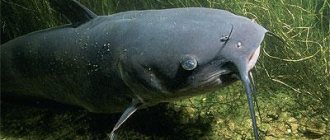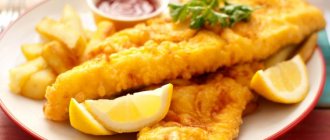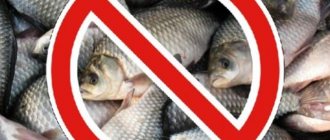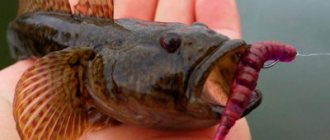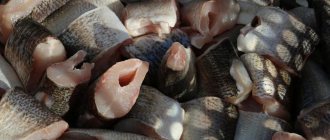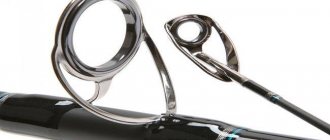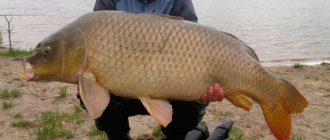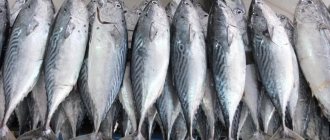If you have never held a fishing rod in your hands, and have only seen live fish in an aquarium or on the “Hunting and Fishing” channel, then this article is for you.
You have firmly decided to learn how to fish. Like any other business, any fishing trip will require some preparation. It is necessary to collect information and prepare a “material base”.
Preliminary information
To get acquainted with fishing, there is no point in going to the remote taiga or to a huge lake. To understand how and what to do when fishing, you can practice on a small body of water somewhere nearby. A small lake or river will do. I recommend studying on reservoirs without a current, if possible with a clean bank and a flat, hard bottom.
Advice! Collect information about bodies of water.
The easiest way to find out something about bodies of water located in relative proximity is to use some service like Google Maps or WikiMapia. On the map you can always find up to a dozen such reservoirs, from village fire ponds and streams to reservoirs, ponds and rivers.
Some fishermen leave important comments from the point of view of information content on such resources:
- depth of the reservoir in different areas;
- information about the species of fish living in the reservoir, its size and bait;
- fishing methods and possible baits.
This information will help in preparing for going out onto the pond.
It would be nice to get to this body of water at least once before fishing, take a closer look, chat with local regulars, just walk along the shore, identifying places with stands for fishing rods.
If there is such a stand on the shore, it means that someone is fishing here. And if it catches, it means there are fish in this place. In places with stands you need to carefully inspect the shore. Along with cigarette butts, the following may remain on the shore:
- cups or syringes with remaining batter;
- empty jars of peas or canned corn;
- containers with the remains of soil (in which the red worm is usually stored);
- jars with sawdust (maggots are stored in such containers);
- plastic bags or paper bags (in which bloodworms are usually sold).
These items will help you decide on the choice of bait. This information is quite enough for your first fishing trip.
Advice! If you manage to get a local fisherman to talk, listen carefully and try not to interrupt. These people are not spoiled by attention. To rejoice that they have found a grateful listener, they can give out a lot of useful information on bait, gear, places and times of fish biting.
Fishing safety rules
- While on the shore, you should remember that the area may collapse. For safety reasons, it is recommended to choose a place where the shore protrudes slightly above the water and is surrounded by bushes.
- Caution should be exercised when walking on rocks. Rocks underwater become covered with algae, making them very slippery.
- When moving through wetlands, you should carefully feel the soil with a stick.
- Winter fishing is the most dangerous. Going out on the ice must be accompanied by a thorough strength test. Safe ice thickness is from 7 centimeters. To check the thickness, you first need to punch several test holes.
- Hazardous situations include lightning and thunderstorms. You should not go out to the river if the weather conditions are far from ideal. Water is an excellent conductor of current, so getting struck by lightning is not difficult.
- It is not advisable to sail far on a boat if a person does not swim confidently. Be sure to have a swimming vest with you.
- Carefully check all equipment before going fishing.
Preparing for fishing
At a minimum, you will need:
- Equipped fishing rod;
- Lures;
- Consumables;
- Container for storing fish.
You can assemble and equip the fishing rod yourself by first purchasing a rod, reel, main line, float, set of weights, leader line and hooks.
But for the first time it’s better to buy yourself an equipped telescopic rod up to 4.5 m long. Almost any fishing store sells such rods. You can ignore the manufacturer at first. The Chinese have learned to counterfeit all brands.
Such a rod can last for a year or ten. They are not expensive. It’s difficult to call the quality high, but catching a trophy on your first fishing trip is even more difficult. It’s easy for an inexperienced fisherman to break an expensive, light, but rather fragile fishing rod.
You still have to buy spare parts. You will need:
- Main line (section from 0.18 to 0.24 mm);
- Line for leashes (section from 0.10 to 0.14 mm);
- Floats with a carrying capacity from 1 to 2.5 grams (at least 3 pieces with clearly visible antennas);
- Set of pellet sinkers;
- Hooks No. 8, No. 10 and No. 12 (according to the European numbering system) per pack. You can use non-Japanese ones (Kamatsu or Gamakatsu). For fishing for relatively small fish, an Osko or Cobra will suffice.
Advice! Do not be fooled by the persuasion of a seller who will try to sell you the most expensive thing he has. Choose accessories in the mid-price range.
The choice of bait depends on what kind of fish lives in the pond. But the following are considered universal baits:
- In spring - bloodworms and maggots;
- In summer - red worm, maggot, dough, mash and pearl barley;
- In autumn - red worm, maggots and bloodworms.
Advice! Fish, however, may have its own special opinion on this matter. That is why preliminary collection of information about fish and its taste preferences in each specific body of water is necessary. Try different baits while fishing.
Fishing baits are best stored in a dark, cool place.
How to dress for fishing?
In addition to quality outdoor gear, it is important to choose the right clothes.
It must meet the following requirements:
- be comfortable;
- protect from cold and heat;
- moisture resistance;
- differ in functionality.
For winter holidays, the most important criterion is warmth. The warmer the clothes, the better. The main thing is to protect your legs and arms to avoid hypothermia.
Unlike the winter period, there are more clothing options for summer fishing. Each fisherman selects equipment to suit his taste, based on basic principles.
The color scheme of the equipment allows you to camouflage yourself among nature so that the prey does not notice the fisherman. Functional overalls allow you to always carry the necessary equipment with you.
At the end of winter and spring, it is recommended to go fishing in a long jacket and pants. In cold weather, it is advisable to have an insulated layer. An excellent solution would be a vest made of cotton fabric. Zipper closures add convenience to these items. The spring set also includes warm underwear and sweaters, one warmer, the other thin.
When choosing summer clothes, a person should be guided by his feelings, taking into account the following rules:
- In summer, biting insects are most active, so clothing should cover the body;
- clothing must be durable, since it is likely that you will have to wade through thickets of trees and grass;
- the ability of clothing to impart camouflage;
- It is recommended to take a raincoat or film with you;
- headdress is required;
- waterproof shoes. Preference should be given to high boots, which not only protect from moisture, but also protect a person from snakes, which often live near water.
Fishing time
Typically, the best bite for any fish on any body of water in ideal weather conditions begins in the morning, at dawn and ends around 11.00. Then there is a pause when only very small fish are caught on the hook. The bite is restored around 16.00 and can continue until dusk. You can also estimate with the help of a biting calendar what time and how the desired fish bites.
There may be some nuances. During the hot summer months, fish may bite in shallow waters only at night. In cold, deep reservoirs (peat, clay and chalk quarries), the bite can start quite late even in the very heat.
Advice! Each body of water lives its own life, according to its own laws, to which the fish living in the body of water also obey. These laws must be understood and used for your own benefit. Remember the “routine” of the life of the reservoir.
Selecting a location
When you find yourself on a new body of water for the first time, you need to choose a fishing spot. Try to choose it in such a way that:
- the rising Sun would not blind you, it would be behind you;
- casting was not interfered with by branches of trees and bushes from behind and on the sides;
- in front of you was a fairly open area of a reservoir without water lilies, egg capsules and other strong and “tenacious” vegetation or snags.
In this place it is necessary to clean the shore from crispy twigs and rustling grass. Place a stand under the rod and figure out where the fish tank or bucket will be located.
Advice! For the first fishing, the criteria for choosing a fishing spot are a necessity. In the future, when the noble art of precise casting becomes the norm for you, such “difficult” places will become most attractive to you. Remember them.
What to do if a fish gets tangled on a fishing rod?
In order to remove an entangled fish, you must first remove the hook, weight and float. If you are using a spinning rod, remove the spoon. The next step is to cut the line and untangle the fish.
If the lure is on a leash, then remove the leash from the carabiner and untangle it.
Fishing
- Before each exit, you should check the functionality of the brake on the reel.
- The fish should not be allowed to pull the line in line with the rod. In such a situation, control over the fish will be completely lost.
- In the process of reeling in fish, you should not reel in the fishing line as much as possible.
- The fish is placed into the landing net from the head.
- If a fish struggles on the surface and jumps out, you should let it go a little so that it goes deeper.
- You need to pull the fish strictly in the opposite direction from its movement.
Lure
On your first fishing trip and in small bodies of water, you don’t need to use bait.
Preparing gear
- We unfold the rod, first lifting the line handler bracket to release the line.
- We check the strength of the knees and the orientation of the passage rings. The rings should be in line with the coil.
- We check the presence and strength of fastening of the float to the main fishing line and the reliability of fastening of the sinkers.
- We check the hook and, if necessary, change it to another one that is more suitable in color and size to the bait.
- We set the depth by moving the float along the main line.
Advice! It’s good to at least have a rough idea of the nature of the bottom and its topography at the fishing spot. To do this, you can use either a depth gauge or a portable sonar.
Rules of conduct when fishing
- When going fishing, it is prohibited to drink alcohol.
- You should be careful during a thunderstorm. If bad weather catches you on the spot, then get away from the water and trees.
- In the summer season, choose clothes that allow air to pass through well and protect against pests.
- In winter, you should definitely check the ice for strength.
- Fish with caution on banks that may collapse.
- Choose only permitted places.
Casting
At first, beginners are recommended to cast the bait using a method called a “pendulum”. This is the simplest, most accurate and quietest way to cast gear.
We hold a fishing rod in one hand. In the second gear (for a hook with bait). We choose a casting location at a distance of no more than 9 meters (at first it is better not to cast to a distance that is more than twice the length of the rod).
With a confident movement, we raise the tip of the rod and at the same time release the hook with the bait. The bait flies in the direction of the target. It’s better to throw it slightly, then pull it to the fishing spot. In this case, the fish will not be so scared, and the line can be submerged so that it is not carried away by the wind and surface current.
This casting method has one very serious drawback - it is ineffective in windy weather.
Advice! If possible, at first choose a fishing spot so that the wind blows from behind you, helping to cast the tackle.
How many fishing rods do you need for fishing?
The number of fishing rods for regular fishing is in the range of 2-3. If a fisherman goes to the lake, you can take 4-5 gear with you. First of all, it is important to assemble high-quality equipment.
It is not recommended to take a lot of fishing rods, as this is not always convenient and practical. If a person is just starting to fish, then having a lot of installed fishing rods will help him get to know the place better. After a person gets used to the pond, it is better to remove the extra fishing rods and leave a few.
It has been established that fish often bite in only one place. Therefore, many fishing rods do not guarantee successful fishing.
Experienced fishermen use a maximum of three fishing rods, keeping an eye on them all at the same time, changing baits on time and not creating discomfort for other fishermen.
Bite
If the depth is chosen correctly and the float is correctly submerged, only the float antenna will stick out of the water. She needs to be watched. You need to hook, that is, pull the tackle towards you with a small sharp jerk, if the float:
- Lay down on the water;
- He bent down and slowly swam to the side;
- Went under water;
- It stands still, but small but noticeable circles spread out from the antenna on the surface of the water.
Advice! There is no need to rush with hooking at first. When you bite, mentally count to three and only then hook.
The influence of weather on the bite
Water temperature
- It is better to catch salmon at 12-18°C, and cyprinids at 23-28°C.
- A decrease in temperature after prolonged heat helps to improve the bite.
- Sudden changes in temperature lead to minimal bite for several days.
- A gradual increase in temperature, tending to a normal level, promotes the best fishing.
Weather
- The scorching sun scares away the fish.
- During hot weather, the most optimal time for fishing is early morning and late evening.
- Increased atmospheric pressure and cloudiness provide the best catch.
- If the sky is overcast, it’s a bad catch.
- Warm, uniform and not heavy rain ensures good fishing.
- During cold rain, it is better to stay home.
- Successful fishing is possible before and after a thunderstorm.
- Strong winds in any direction are not conducive to favorable fishing.
- The new moon is the most optimal period for going fishing, unlike the full moon.
Releasing the hook
The baited hook may end up deep in the fish's throat. To get it out, fishermen use either an extractor or regular tweezers.
The bait can and should be changed for a fresh one every 10-15 minutes. But if the fish does not approach your bait for more than one hour, it is better to change the lead line to a thinner one, change the float to a very light one, and experiment with depth. If this does not help, you need to change the fishing location altogether.
Advice! If your very first fishing trip is not successful, don’t despair. Any body of water is a mystery that needs to be solved. Some people begin to understand the logic of fish behavior immediately, while others will need time and patience. There is no need to rush, try to relax, enjoy communicating with nature.
How to preserve fish in the heat?
- After you have pulled out the fish, you should release it from the hook. The hook should be removed carefully, without putting pressure on the belly of the fish. The less damage the catch receives, the longer it will remain fresh. If the fish is badly damaged, there is no need to throw it to another catch, but rather put it in a separate place.
- Based on the first rule, you should periodically monitor the condition of the fish. Half-dead or completely dead fish are isolated in a separate container.
- If fishing takes several days, the fish should be gutted immediately and preferably frozen.
- The use of a wicker cage, which is lowered into water, is encouraged. In this case, the device must be spacious so that the catch can float. A cramped and metal cage can damage the scales and body of the fish.
- The cage is selected with a fine mesh, into which the fish’s head will not fit. By sticking your head in there, the catch can simply suffocate.
- The container with the prey is placed in a dark place.
- Toothy fish should not be placed in a fabric container as they may escape. For predators, they use a kukan with a metal loop at the end, on which the fish is strung and left in the shade.
